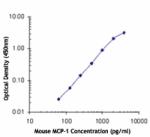- Clone
- 4E2/MCP (See other available formats)
- Regulatory Status
- RUO
- Other Names
- Monocyte chemoattractant protein-1, Monocyte chemoattractant and activating factor (MCAF), JE, Small inducible cytokine A2 (SCYA2), HC-11, P6, Smooth muscle cell chemotactic factor (SMC-CF), CCL2
- Isotype
- Hamster IgG
| Cat # | Size | Price | Quantity Check Availability | ||
|---|---|---|---|---|---|
| 506004 | 500 µg | $235.00 | |||
Monocyte chemotactic protein-1 (MCP-1) also known as monocyte chemotactic and activating factor (MCAF) was identified based on its ability to chemoattract monocytes. Subsequently, MCP-1 has also been found to regulate adhesion molecule expression and cytokine production in monocytes. MCP-1 is identical to the product of the JE gene, a PDGF inducible gene. MCP-1 is a member of the beta (C-C) chemokine subfamily, known as CCL2. The 4E2/MCP antibody reacts with mouse MCP-1. This antibody does not react with human MCP-1 and related mouse beta chemokines, TCA3 and MIP-1beta. The 4E2/MCP antibody can not neutralize the bioactivity of natural or recombinant MCP-1.
Product Details
- Verified Reactivity
- Mouse
- Antibody Type
- Monoclonal
- Host Species
- Hamster
- Immunogen
- CHO-expressed, recombinant mouse MCP-1
- Formulation
- Phosphate-buffered solution, pH 7.2, containing 0.09% sodium azide.
- Preparation
- The antibody was purified by affinity chromatography.
- Concentration
- 0.5 mg/ml
- Storage & Handling
- The antibody solution should be stored undiluted between 2°C and 8°C.
- Application
-
ELISA Capture - Quality tested
WB - Reported in the literature, not verified in house - Recommended Usage
-
Each lot of this antibody is quality control tested by ELISA assay. For use as an ELISA capture antibody, a concentration range of 1-4 µg/ml is recommended. To obtain a linear standard curve, serial dilutions of MCP-1 recombinant protein ranging from 1000 to 8 pg/ml are recommended for each ELISA plate. It is recommended that the reagent be titrated for optimal performance for each application.
- Application Notes
-
ELISA or ELISPOT Capture: The purified 4E2/MCP antibody is useful as the capture antibody in a sandwich ELISA or ELISPOT assay, when used in conjunction with the biotinylated 2H5 antibody (Cat. No. 505908) as the detecting antibody for the detection of mouse MCP-1. The LEAF™ purified antibody is suggested for ELISPOT capture.
Additional reported applications (for the relevant formats) include: Western blotting1. The 4E2/MCP is a non-neutralizing antibody1. -
Application References
(PubMed link indicates BioLegend citation) -
- Luo Y, et al. 1994. J. Immunol. 153:3708.
- Luo Y, et al. 1999 J. Immunol. 163:3985.
- Product Citations
-
- RRID
-
AB_2290924 (BioLegend Cat. No. 506004)
Antigen Details
- Structure
- CC chemokine; dimer; 13.8 kD (Mammalian)
- Bioactivity
- Chemoattractant; regulates adhesion molecule expression, cytokine production in monocytes; proliferation/activation of CC-chemokine activated killer cells
- Cell Sources
- Monocytes, vascular endothelial cells, smooth muscle, glomerular mesangial cells
- Cell Targets
- Monocytes, basophils, T cells, NK cells, immature dendritic cells
- Receptors
- CCR2; CCR5; CCR10; D6; possibly L-CCR
- Biology Area
- Cell Biology, Neuroinflammation, Neuroscience
- Molecular Family
- Cytokines/Chemokines
- Antigen References
-
1. Fitzgerald K, et al. Eds. 2001. The Cytokine FactsBook. Academic Press San Diego.
2. Bischoff S, et al. 1992. J. Exp. Med. 175:1271.
3. Charo I, et al. 1994. P. Natl. Acad. Sci. USA 91:2752.
4. Jiang Y, et al. 1992. J. Immunol. 148:2423. - Regulation
- Upregulated by IL-1, TNF-a, PDGF, TGF-ß
- Gene ID
- 20296 View all products for this Gene ID
- UniProt
- View information about MCP-1 on UniProt.org
Other Formats
View All MCP-1 Reagents Request Custom Conjugation| Description | Clone | Applications |
|---|---|---|
| Biotin anti-mouse MCP-1 | 4E2/MCP | ELISA Detection,ELISPOT Detection |
| Purified anti-mouse MCP-1 | 4E2/MCP | ELISA Capture,WB |
Compare Data Across All Formats
This data display is provided for general comparisons between formats.
Your actual data may vary due to variations in samples, target cells, instruments and their settings, staining conditions, and other factors.
If you need assistance with selecting the best format contact our expert technical support team.

